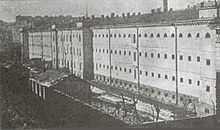Pawiak


Pawiak (Polish pronunciation: [ˈpavjak]) was a prison built in 1835 in Warsaw, Poland.
During the January 1863 Uprising, it served as a transfer camp for Poles sentenced by Imperial Russia to deportation to Siberia.
During the World War II German occupation of Poland, it became part of the Warsaw concentration camp. In 1944 it was destroyed by the Germans.
History
The Pawiak prison took its name from that of the street on which it stood, ulica Pawia (Polish for "Peacock Street").

The Pawiak was built in 1829–35 to the design of Fryderyk Florian Skarbek, prison reformer and godfather of composer Frédéric Chopin.
During the January 1863 Uprising, the prison served as a transfer camp for Poles sentenced by Imperial Russia to deportation to Siberia.
After Poland regained its independence in 1918, the Pawiak became Warsaw's main prison for male criminals. (Females were detained nearby at Gęsiówka.)

Following the German invasion of Poland in 1939 it was turned into a German Gestapo prison, and then part of the Warsaw concentration camp. Approximately 100,000 men and 200,000 women passed through the prison, mostly members of the Armia Krajowa, political prisoners and civilians taken as hostages in street round-ups. An estimated 37,000 were executed and 60,000 sent to German death and concentration camps.[1] Exact numbers are unknown, as the prison's archives have never been found.
During the Warsaw Ghetto Uprising, the Pawiak became an assault base for the Nazis. Jailers from the Pawiak, commanded by Franz Bürkl, volunteered to hunt the Jews.
On July 19, 1944, a Ukrainian guard, Wachmeister Petrenko, and some prisoners attempted a mass jailbreak, supported by an attack from the outside, but failed. Petrenko and several others committed suicide. The Resistance attack detachment was ambushed and suffered very heavy casualties, practically ceasing to exist. In reprisal, over 380 prisoners were executed the next day. It is thought that the whole incident was actually a well-planned Gestapo provocation.
The final transport of prisoners took place shortly before the Warsaw Uprising, on July 30, 1944. Two thousand men and the remaining 400 women were sent to Gross-Rosen and Ravensbrück. Afterwards the area was secured during the Warsaw Uprising but subsequently again lost to German forces. On August 21 an unknown number of remaining prisoners were shot and the buildings burned and blown up by the Nazis.[1]
After World War II, the building was not rebuilt. Since 1990, its surviving basement has held a museum which, with the Mausoleum of Struggle and Martyrdom, forms the Museum of Independence.
-

Ruin of Pawiak prison gate in 2008
-
Memorial tree and (background) Pawiak Museum in surviving basement of the prison
See also
| Wikimedia Commons has media related to Pawiak. |
- Gęsiówka
- Łapanka
- Mokotów Prison
- World War II crimes in Poland
References
- ↑ 1.0 1.1 History of the prison - official website of the museum
External links
Coordinates: 52°14′47″N 20°59′26″E / 52.24639°N 20.99056°E
